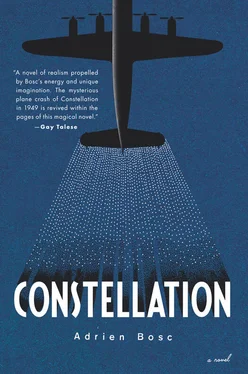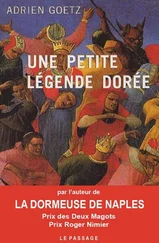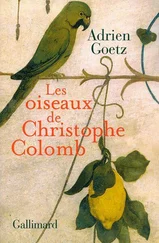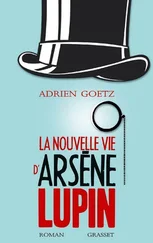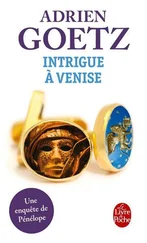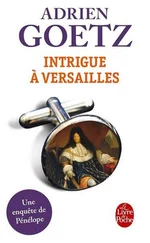Lévis-Mirepoix wants to start tracking down the looters immediately. At dawn, the commissioners inspect the houses in Algarvia, questioning the inhabitants. A pearl necklace and wedding rings turn up here, a wad of dollar bills there. And what to make of the woman they stop in the street wrapped in a fur coat? At some distance from the village, along a path, the sounds of a violin rise from a shack. They knock on the door, the noise stops, an old man opens, holding his instrument and a bow trimmed with tortoise shell and gold.
— Is this yours?
— No, I found it, the man answers.
The bow, a “Fleur-de-Lys” model, bears the mark of W. E. Hill & Sons, the famous London violin makers. The commissioners immediately confiscate the bow, the violin — an old one — stays with the countryman.

At noon, the army organizes the removal of the coffins to the base at Ponta Delgada. Four trucks serve as hearses, trundling along the hairpin road that separates Algarvia from the Santana airfield. Two hours later, the coffins sit on benches in the dining hall of the whitewashed barracks. It is Monday, October 31, the row of unlabeled caskets, decorated with wreaths and garlands, and the improvised altar give the infantry canteen the aspect of a morgue. Ponta Delgada is the capital of São Miguel. Known as “Ilha Verde,” the island at one time was a reprovisioning point for caravels between Europe and the New World, a bustling hub. The Praça Gonçalo Velho Cabral, ringed on four sides by arcades, marks the last terrestrial gate to the sea with three proud arches. The walls of the Forte de São Bras beetle over the citadel. On the fifth Sunday after Easter, the residents strew the flagstones of the city with island flowers. They celebrate the Holy Ghost, and a procession forms behind an enormous Christ made of painted ebony, splashed with gold and diamonds. In the parish church, the gathered crowd consecrates a child as emperor, on his head the magnificent crown, in his hand the hundred-year-old scepter. The baby-king files out and opens the festivities.
What wood are the coffins in the barracks made of, wood from the vast forests in the vale at the center of the island? That afternoon, the absolution of the dead is performed by the priest of Ponta Delgada. Present are the civil governor, the chief local authorities, the members of the Air France mission. The coffins are grouped by nationality, some draped in the Union Jack, some in the Stars and Stripes. The French will have to await the arrival of Consul Morin, presently in Lisbon. After the Catholic service, a Protestant American chaplain in an air force uniform reads out verses from the Old Testament. Outside, the flags on the base are flying at half-mast, Portuguese soldiers march at attention in front of a double row of schoolchildren, dressed all in white.
Lévis-Mirepoix speaks that night with Didier Merlin of Le Figaro and reports on the early stages of the investigation: “It’s still too early to draw conclusions from the elements we’ve gathered. Every member of the commission, coordinating, of course, with the others, has conducted his own inquiry, in the area assigned to him by his specialty. We have been accompanied by representatives of the flight personnel: a pilot, a radio operator, a navigator, and a mechanic, charged with gathering information relative to their roles when flying. We have not yet been able to examine the information we have gathered. Each of us holds a piece of the puzzle that makes up the disaster, but will it not always be a riddle, even when all the pieces have been assembled? The aircraft, as you know, crashed into the mountain on the side of Mount Redondo, between Redondo and Algarvia Peak, the highest on the island of São Miguel, thirty miles from wider, flatter ground that might be considered a small pass.”
I remember that Ginette Neveu died in the same airplane as Marcel Cerdan.
— Georges Perec, I Remember
Encircling the advertising columns along Paris’s boulevards, posters for the Salle Pleyel theater announce in capital letters and in Indian file:
PRIOR TO HER DEPARTURE
GINETTE NEVEU
WILL PERFORM A FAREWELL CONCERT
THURSDAY OCTOBER 20
AT THE SALLE PLEYEL
On the program for this last turn at the violin before the Americas, Handel’s Sonata in D Major, Bach’s Chaconne in D Minor for solo violin, Szymanowski’s Nocturne and Tarantella , and Ravel’s Pièce en forme de Habanera and Tzigane . Her long pink gown framing her gladiator’s shoulders, Ginette Neveu, accompanied on the piano by her brother, Jean, bows her instrument for an hour without letup, her impeccable interpretation of the repertoire both nimble and passionate. The public has come to hear this prodigy, this Mozart in a dress, whose praises the whole world is singing. Especially to hear her Tzigane , encored after each movement as usual, an eight snaking around a caduceus. In Paris, between two concerts, Ginette remains closeted in the family apartment on the square Henri-Delormel. Endless hours spent rehearsing the program, bringing the slightest detail to perfection, digging to the edge of madness for the right interpretation. Then, in the early light, walking the broad avenues, strolling in the hour between dog and wolf among the invisible fraternity of lone early birds. At the age of ten, she wrote in a composition: “Even better are the Champs-Elysées when the cool morning air and glorious light make for an indefinable grandeur, one that you don’t experience during the day. The few out walking aren’t speaking, they are contemplating … But in two hours, the pedants will have retaken possession of the avenues, the enchantment will be gone.”
That morning, she sees the great posters to her glory. In one stroke of the paperhanger’s brush, a SOLD OUT strip extends across each ad. Ginette chose her fate. It is easy to attach the label “prodigy” to her precocious career and miss, through facile stereotyping, the child’s implacable will, hard work, and discipline, the mailed fist of her genius. A staccato like no other, fruit of the obstinacy of a serious child. We like fairy tales, Newton’s apple, eureka moments, grace conceived as a punctual, innate, and ineluctable event, and we erase, because of our penchant for the marvelous, the prior groundwork, the tedious chores, the doubts. At seven, after a first concert at the Salle Gaveau, Ginette trains hard to overcome her anxiety, stop the trembling in her knees, conquer the sweat on her forehead and palms. In the evening, standing on the kitchen table practicing, she tells her astonished mother: “It’s to get used to performing onstage. The other day, I had stage fright, it was probably vertigo.”

An Armistice baby, Ginette Neveu is born in 1919 in Paris. Her mother, a piano teacher, introduces her to music early. Ginette watches the students come and go from a corner of the living room and, at eleven months, hums the melodies she has heard. Passersby stare at this baby carriage rocked by its own lullabies. At two, she attends a concert in tribute to Frédéric Chopin, on the way home, in tears, she is heard to say, “How much feeling he shows! Oh, how unhappy that man must have been!” Her first violin, quarter-sized, is presented to her when she turns five, and her parents enroll her, on the advice of Professeur Nadaud of the Paris Conservatory, to take courses with Mme Talluel. In no time at all, staccato, spiccato, jeté bowing, sautillé hold no secrets for her. On the evidence of her unusual maturity, six months after starting to study violin, Ginette gives her first public recital, performing a Schumann fugue. She receives her first applause, which she doesn’t understand, and, after a curtsy, she imitates the audience’s clapping. Two years later, Ginette shines at the Salle Gaveau, she gives a brilliant performance of Max Bruch’s Concerto no. 1 in G Minor. Outside, a violent storm crashes down, she doesn’t hear the noise. To her mother, surprised at her unflappable aplomb, she answers: “Thunder? There was a storm?”
Читать дальше
